The definition of a positive experience is arbitrary and varies between individuals or situations. For this reason, understanding your user is essential to the user experience design process. Even if we can only sometimes determine what constitutes a good user experience, some standards and principles can help us and serve as a guide for good UX/UI design.
Let’s start with a simple question: What is the goal of a good UX/UI design?
It could be tempting to focus primarily on content that helps visitors understand what you want them to know (like product specifications) and do (like clicking the “purchase now” button).
However, the objective of good UX is to enable users to interact with your company as they desire.
It would be best if you thought about how users are affected by your website and mobile applications. Do they understand you? Are you coming across as an emotionless person? Is your design rushing your users?
There’s a lot to think about.
The user doesn’t care what your data research says; they only care about how it works. Overthinking any design will typically lead to an overly-complicated product. The solution is to design the product right the first time and ensure it does exactly what it should do and nothing that it shouldn’t.
Let’s understand this step-by-step.
What are User Experience (UX) and User Interface (UI)?
- User experience (UX) design is how customers interact with a website, app, or product. UX design accepts that we must design for the experience, not the aesthetic.
- User Interface (UI) design is a technique designers use to create user interfaces in software or electronic devices with a focus on aesthetics or style.
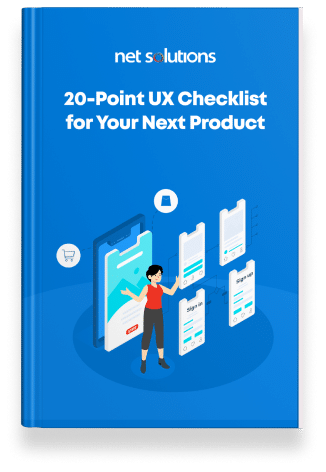
We respect your privacy. Your information is safe.
What is the relationship between UX and UI?
The user interface (UI) refers to the look rather than the function of a website or product. Put another way: while UX is a process of understanding what a user wants and feels, the UI is the result — the digital product developed to deliver a service or product to a user.
UX design considers seven elements as expressed by the user experience honeycomb created by Peter Morville and further optimized by Katerina Karagianni in terms of how customers use products, as well as how they think and feel about them:

User experience (UX) describes every customer interaction with your company and products. It’s no longer just about the product but the experience of purchasing and using it: whether it was easy to use, enjoyable, practical, or met a specific need. 70% of CEOs now see user experience (UX) as a competitive differentiator, helping to attract, convert, and retain customers. Indeed, for every $1 invested in UX, brands can see an average of $100 in return – an ROI of 9,900%.
UX design (UXD or UED) operates with the following questions in mind:
- Is it useful? The product or service must fulfill a customer’s wants or needs. Greater depth of information and originality will be the usefulness factor.
- Is it desirable? The product, service, app, or system should be aesthetically pleasing and to the point. This is a dynamic element; the design focuses on image and branding more than function.
- Is it findable? Is the site or service easy to use? Is the site easy to find? Is internal navigation to find information or make a purchase as streamlined as possible?
- Is it usable? Here we examine ease: how quickly and efficiently can someone do what they came to do? UX design will consider the number of clicks, server speed, and even the familiarity of the design.
- Is it accessible? Do all users experience the product or service the same way?
- Is it credible? Considerations such as quality and reputation are essential regarding trust. Social proof (e.g., online reviews) is how customers measure credibility today.
- Is it valuable? Customers prioritize different aspects of their experience over others so that we can consider value as the ideal mix of all the other six variables in the honeycomb.
UI is just one point in the user experience (UX) journey.
UI design, often known as interface design, is about the look of a website, the design, colors, placements, and fonts. Are you aesthetically pleasing? Is it usable? UI overlaps with the “desirable” and “usable” factors in the UX honeycomb but only represents a customer’s digital interactions.
Let’s take a specific example to illustrate our point. Imagine you are a seller of organic, all-natural toothpaste – take a look at what a UX designer and a UI designer would consider:
UX designer
- How did you find our website?
- Where did you come from?
- What was your first impression of our website?
- How easy was it to find the product you wanted, read about it, and hear from other customers?
- What information ultimately influenced your purchase decision?
- How was the checkout process (fast, smooth, and easily connected to purchase options)?
- Did you like the product and its packaging?
UI designer
- What visual cues helped you find the right product and support your decision?
- Does the design look good on any screen size and resolution?
- Is the website aesthetically pleasing?
Notice that the UX designer focuses on interactions with the customer while the UX designer focuses on aesthetics.
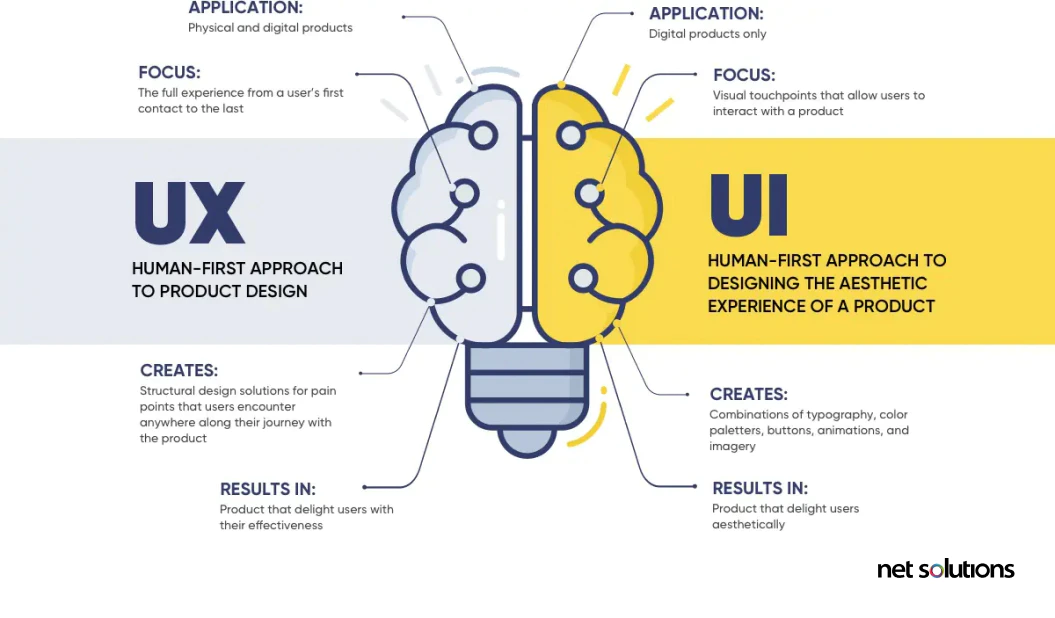
Though UX and UI approach design from different perspectives, there is naturally a lot of harmony and overlap between their goals. In some cases, either or both roles can be held by a designer. UX design often includes contributions from business analysts and QA professionals that help enhance the design experiences for the users.
What Makes a Good UX Design?
Great user experience design takes the time to define the customer (persona), the problem, and the best strategy for tackling the problem. This is why it’s important to partner with an experienced experience design agency that can help your organization create a cohesive vision and strategy for delivering a great user experience design. UX design takes a lot of work, but with the right agency by your side, your organization can achieve its UX goals and delight your customers.
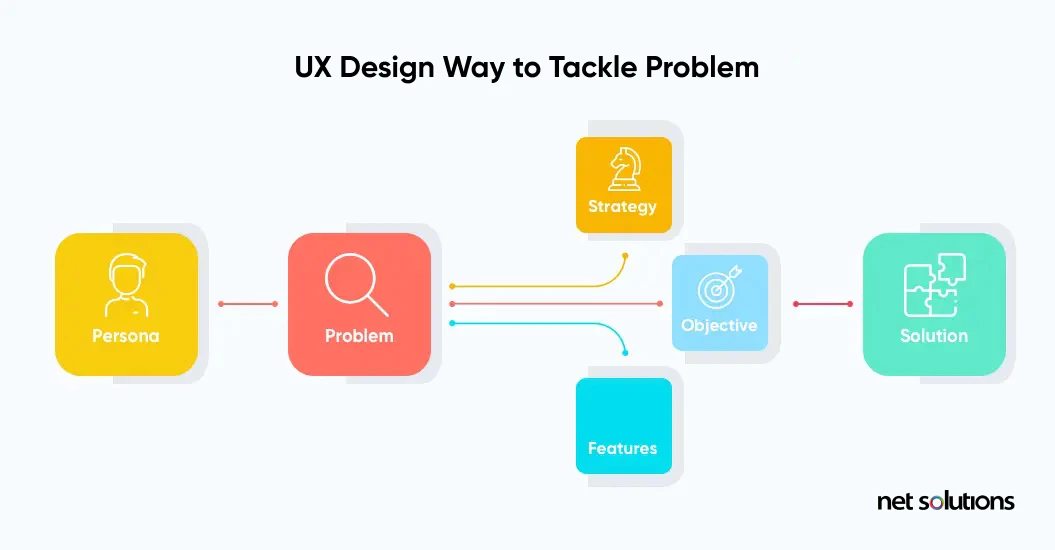
Remember, the customer-centric terms we identified earlier should evaluate good UX design: whether the product is practical, usable, findable, credible, accessible, desirable, and ultimately valuable.
Let’s talk about how we can design for the user experience.
Managing the User Experience
Testing can help you refine your UX design, but good design begins much earlier. Good design will require understanding who your users are and what they need.
Good UX design means thinking like a user and providing a clear pathway to aid users in achieving goals when interacting with the product. Managing the user experience involves an 8-step design process:
- Interview stakeholders to understand user behavior and constraints and identify pain points. This stage helps define the business goal of a product.
- User research will help identify user personas (who are the buyers) and user journeys (the paths used to complete specific tasks), enabling you to pinpoint the features you need.
- The UX audit reveals any less-than-perfect aspects of your current website, app, or product that could lead to audience drop-off or churn.
- Define your requirements: what kind of project are you doing, what does it look like, and how does it support the customer and their problem?
- Create a wireframe or information architecture (IA) as a skeleton for what you will create and how it works.
- Create the visual design, focusing on what it looks like (UI) and how it works.
- Prototype with an interactive simulation that allows for input from stakeholders and users. Review and refine based on input.
- Test with real users, going beyond the primary input you received with prototype users. Testing can involve many approaches, including usability testing, analytics, and A/B testing.
As an experienced UX design agency, Net Solutions will ensure you get a good start with your designs. We blend quantitative and qualitative research to understand your user, including observations, field studies, focus groups, interviews, and controlled experiments. Our UX audits will help reveal how users are experiencing your existing products (or those of competitors) through Usability Heuristics and techniques like Cognitive Walkthroughs and Pluralistic Walkthroughs.

Net Solutions leverages an Agile design process that encourages learning, testing, and iterating with users to continually incorporate user experience feedback. The net result is Good Design.
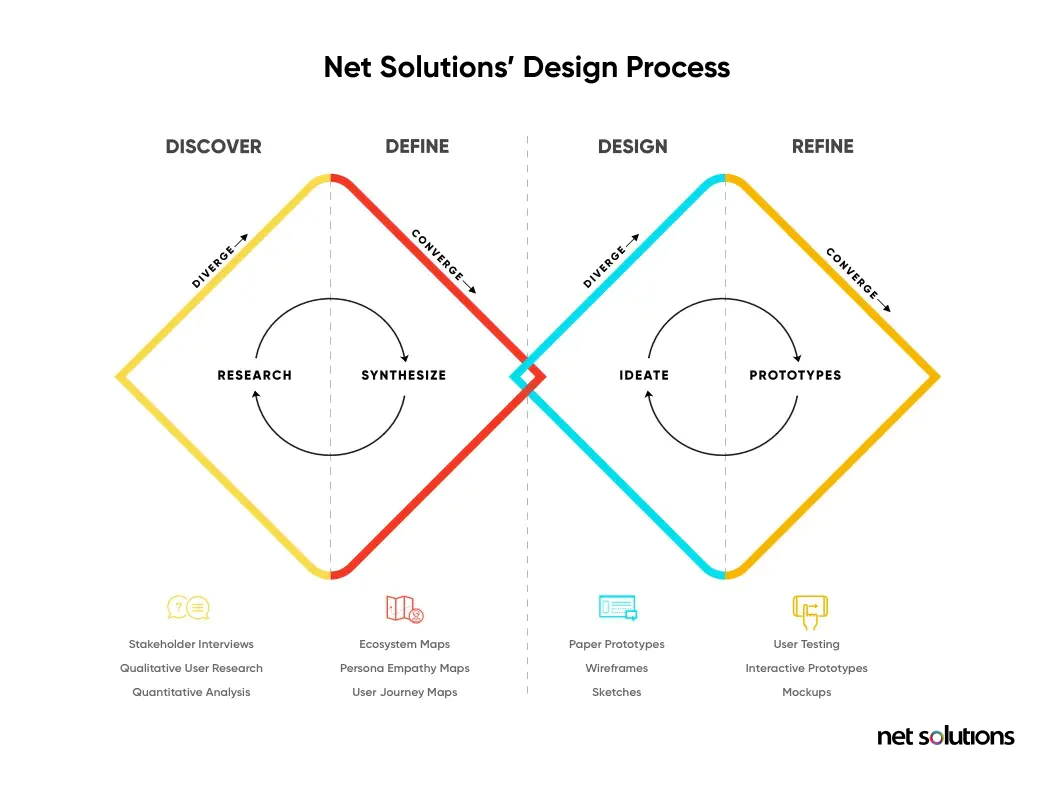
How do you Measure User Experience?
Your design process incorporates user feedback, helping you create a good UX design. But ultimately, you’re going to be asked to prove that. UX measurement includes three types of metrics:
- Perception metrics (e.g., NPA scores)
- Descriptive metrics (e.g., abandonment rates)
- Outcome metrics (e.g., conversion rates, average order sizes, number of calls by reason, how often customers escalate to the call center.)
The Google HEART framework is beneficial for measuring the quality of your user experience.
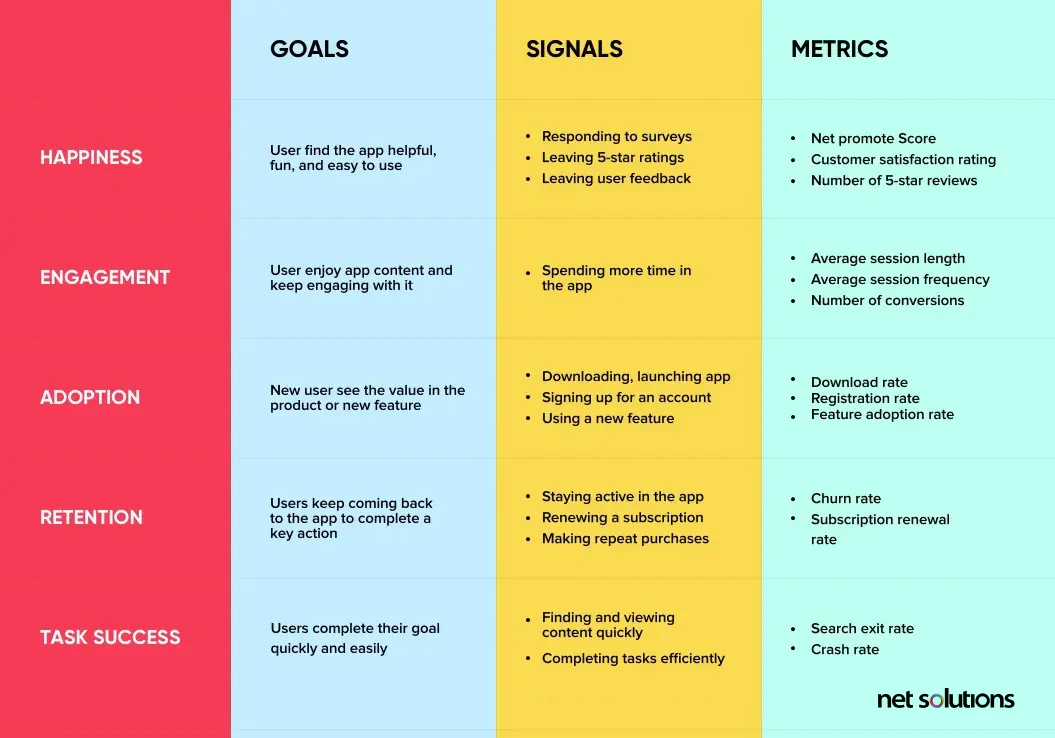
What Makes Good UI Design?
We have already established that UX and UI are different, but a good UI can go a long way to creating a positive user experience. Good UI design is compelling, helping to delight your users. Beyond “delight,” a good UI should be invisible – a user should never notice the menu because they never have to think about where it is or how to use it.
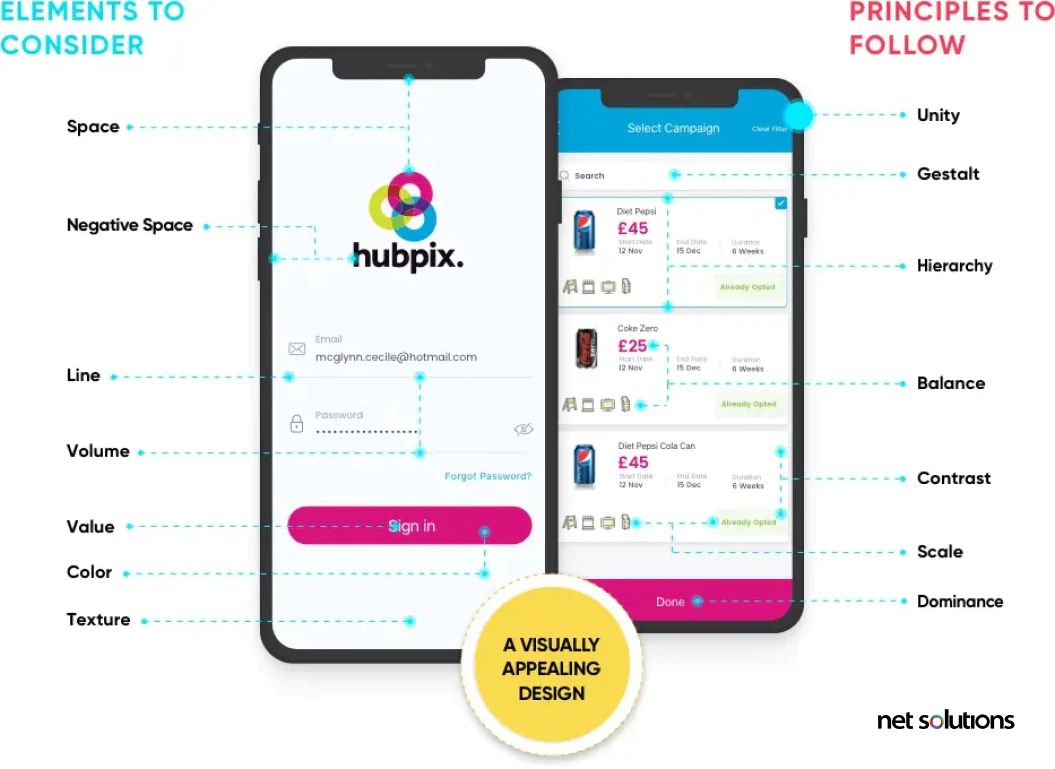
Keeping the latest UX design trends in mind, a good UI is consistent, easy to understand, and matches the brand. Adobe offers the most concise summary of UI design principles:
- Place users in control of the interface (with a focus on “easy”)
- Give them the comfort of interacting with a product
- Reduce cognitive load
- Make user interfaces consistent
Much of good UI is emotive and — you guessed it — driven by the user experience. Delivering delight to your customers requires a full-spectrum approach to design, from research to design, testing, and delivery.
Net Solutions employs experienced in-house experts in UX and UI who can bring your website, commerce platform, or mobile app to life. We utilize the best practices and methodologies during our entire design process to help drive revenue and boost ROI.
How do you measure user interface efficiency?
The KPIs will depend on your goals; some of the most important UX KPIs include task success rate, time on task, user error rate, System Usability Scale (SUS), Net Promoter Score (NPS), and Customer Satisfaction Score (CSAT).
When evaluating a user interface’s design elements, you must assess their overall aesthetics—Do they look fine?—and functionality—Do they work okay? However, you must understand that what makes a user interface look right is entirely subjective.
How can Net Solutions help?
Net Solutions have worked with industry-leading companies to assist them in building world-class design solutions.
Captiv8 is an AI-powered platform that connects companies like Honda and Dr. Pepper with internet influencers, putting their brands in front of the hard-to-reach millennial demographic.
The Captiv8 team turned to Net Solutions to build that unique brand, from the logo to the marketing website that launched their efforts. As the platform caught on with target audiences, Net Solutions worked side-by-side with Captiv8 to build a visually engaging, highly usable system.

We understand that your end users don’t care about the design principles you followed or how much information you’ve gathered and examined about their product usage. The end user cares about the overall experience. And that’s what we’re here to help you with – to offer the greatest possible outcome. Let’s get started.
Frequently Asked Questions
- Review the previous projects
- Communication
- Design knowledge base
- Project management
- Skim through the testimonials/case studies
- Examine the portfolios
- Meet the team
Golden Path (or the Key User Journey) is the key set of steps that a user takes to find a product’s real value. This path should be the ideal default and not concentrate on oddities or errors. Golden Paths should be effortless.
According to Dieter Rams, good design:
- Is innovative
- Makes a product useful
- Is aesthetic
- Makes a product understandable
- Is unobtrusive
- Is honest
- Is long-lasting
- It is thorough down to the last detail
- Is environmentally friendly
- Involves as little design as possible
UX and UI are complementary in product design, and in today’s cutthroat market, getting both parts right is crucial. It’s helpful to learn both, regardless of whether you want to work as a UX or UI designer; after all, you’ll collaborate eventually.

![UI Design_ [And How Net Solutions Can Help] (1)](https://www.netsolutions.com/wp-content/uploads/2022/11/UI-Design_-And-How-Net-Solutions-Can-Help-1.webp)


